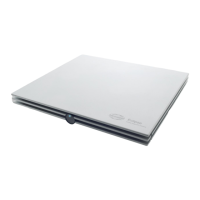Eclipse Additional Information Page 68
3.12 ABR Threshold Determination
For a child not able to co-operate in traditional audiometric tests, ABR is a popular and effective way to eval-
uate hearing threshold.
This is done by testing at different stimulation levels and evaluating the resulting waveforms for responses
related to the sound stimulation. Often a descending stimulation protocol will be used for each ear inde-
pendently. Masking may be applied if a large unilateral hearing loss is found or when testing by bone con-
duction.
It is possible to change from the normal broad frequency range Click stimulus to the more frequency specific
tone Burst stimulation, to obtain a closer resemblance with traditional audiogram findings. Such testing may
reveal responses down into the 10-0dBnHL region for normally hearing babies, depending on many factors
like degree of relaxation, the number of sweeps done and the electrode positioning.
The ABR allows the use of the following stimuli for threshold determination:
NB CE-Chirp® LS & CE-Chirp® LS or NB CE-Chirp® & CE-Chirp®
Click
Tone burst (TB)
3.12.1 Protocol Settings for Threshold Determination
There is variety of test protocols available for Threshold Determination. By default the Threshold Protocols
parameters are the same. The default threshold protocols are optimized for children.

